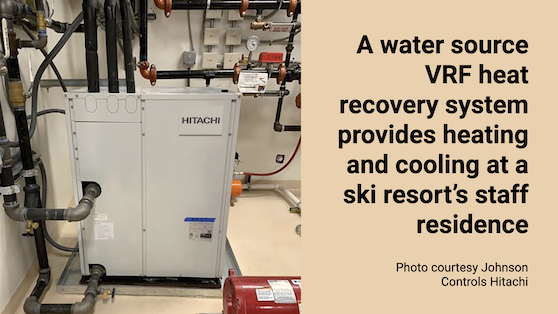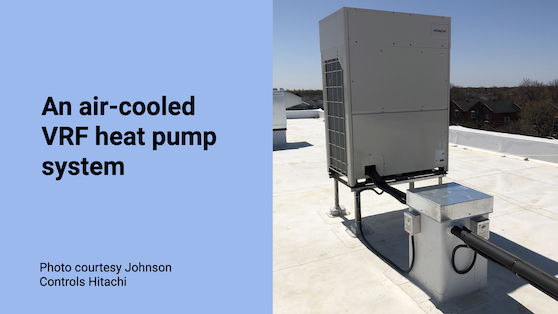
Features
HVAC & Plumbing
In the zone: Comparing variable refrigerant flow systems
VRF systems offer a variety of heating and cooling options
September 1, 2021 By Vipul Chandra
 A water source VRF heat recovery system provides heating and cooling at a ski resort’s staff residence. Photo courtesy Johnson Controls Hitachi.
A water source VRF heat recovery system provides heating and cooling at a ski resort’s staff residence. Photo courtesy Johnson Controls Hitachi. September 1, 2021 – Variable refrigerant flow (VRF) systems are highly versatile and efficient heating and air-conditioning equipment. Essentially, these units feature multiple indoor units that serve different zones but are connected to one primary outdoor core unit.
By cooling and/or heating only the rooms requiring temperature adjustments, VRF systems achieve high energy efficiency and comfort levels while giving the operator greater control over indoor temperatures. VRF systems offer many options: for example, a system can be set up to serve an entire building, simultaneously cooling one floor while heating another.
Most HVAC manufacturers produce two general types of VRF systems—heat pump and heat recovery—each of which is available as either an air-cooled or water source system.
The main difference between the two systems is that, in a heat pump system, all the connected indoor units will be either in heating or cooling mode, but never both. In case of heat recovery systems, indoor units can be in heating and cooling modes simultaneously.
So, depending on the application, design engineers can choose the system that best meets occupants’ expected needs.
For example, in applications where indoor units will be in cooling-mode only year-round (e.g. data centre, marijuana grow operation), a heat pump system is preferred. In applications where different rooms/zones or occupants may require flexibility with heating or cooling (e.g. offices, hotels, condo buildings, hospitals), the heat recovery system is best.
Two options for VRF systems
As mentioned above, most VRF systems are either air-cooled or water source. With an air-cooled system, the heat collected from a zone during cooling mode will be discarded to the atmosphere. In a water source VRF system, that same heat is discarded to a water loop.
Similarly, during heating, an air-cooled system will extract heat from the atmosphere. In the water source system, heat is extracted from the water loop.
In general, a water source system is considered more stable and controllable, as you can easily maintain the water loop temperature of the building. Also, water source systems will not de-rate in heating capacity as do air-cooled systems during ultra-low ambient conditions.

A water source VRF heat recovery system provides heating and cooling at a ski resort’s staff residence. Photo courtesy Johnson Controls Hitachi.
A water source VRF system enjoys several benefits over the air-cooled variety:
• Higher part load efficiency (IEER).
• Higher coefficient of performance (COP).
• Dual-heat recovery from both water and refrigerant circuits.
• Opportunities to use dual fuels: electricity for VRF units and natural gas/electric for boiler units.
• Redundancy of defrost mode.
• No De-rate in heating capacity.
The No De-rate feature is of particular interest. Water source units are installed indoors and, as mentioned, they reject or extract heat from a closed water loop. This is important because it allows water temperature to be easily controlled i.e. with the addition of a small boiler to the loop.

An air-cooled VRF heat pump system. Photo courtesy Johnson Controls Hitachi.
Proponents of air-cooled VRF systems will point out several advantages:
• Easier and cheaper to install overall.
• Do not use floorspace within the structure.
• Roof installation allows flexibility in placement.
• Easier heat rejection to outside air.
Benefits of a water source VRF system
While air-cooled VRF systems boast some good features, the benefits of water source systems cannot be dismissed.
High-rise designers prefer specifying water source VRF systems, typically ordering their installation on each floor. The units then serve that floor or, in some cases, multiple floors. Air-cooled VRF systems are difficult to install in high-rise buildings due to piping length restrictions and price considerations for certain components (namely, they require significant and costly vertical piping installations).
Additionally, coastal structures benefit from water source systems because their condensing units are not exposed to the elements, which offers protection from salty air. Air-cooled units installed outdoors in coastal areas, on the other hand, typically need additional paint coatings to limit rusting.
In ultra-low ambient applications, water source units do not lose heating capacity like their air-cooled counterparts.
The installation of water source VRFs on each floor offers another benefit: the design divides the overall impact of weight and noise throughout the building. Water source units may also get you extra LEED points (Leadership in Energy & Environmental Design) points over air-cooled systems.
Of course, there are some limitations and disadvantages of water source VRF units, including their large interior footprints, requirements for additional piping, rejection system needs, and small piping ranges. While these disadvantages are noteworthy, the benefits of water source VRFs outweigh these considerations and, ultimately, elevate water source units above the air-cooled option.
Extra feature: Priority cooling
The best VRF systems offer a feature called priority cooling, which allows cooling requests to supersede heating demand.
Let’s say a heat pump VRF system with 10 indoor units is working in heating mode, and all 10 units are delivering heat to their specific spaces. Then, one of the indoor units switches suddenly to cooling mode. To satisfy the request for this indoor unit, the condenser delivering heat to all units switches to cooling because it prioritizes cooling requests. The remaining nine units will stop delivering heat and command their connected, supplemental heaters to activate and continue to satisfy the heating requirement in those nine zones.
Meantime, the unit that made the cooling request rapidly lowers the temperature of its zone, meeting that demand.
Priority cooling is available for three types of VRF systems (air-cooled, water source, and the above-mentioned heat pump), allowing you to avoid a heat recovery configuration in your system, which could be cost prohibitive. The larger benefit, however, is that the system—through secondary heating sources—supplies simultaneous heating and cooling. Your occupants will appreciate this level of flexibility.
Extra feature: Emergency heating
VRF systems of all types should also offer an emergency heating feature, and this is an absolute must for Canadian users. With it, supplemental heaters activate should the main condensing unit go offline and become unable to produce heat.
For example, we’re in the midst of a blizzard; the maintenance team plowing the parking lot near your outdoor VRF unit suddenly smashes the unit, which goes offline. The system stops, but heat production continues because the system’s supplemental heaters activate, and fans in the indoor units push heat out to keep the structure warm.
Meeting the challenge for Canadian buildings
Both air-cooled and water source VRF systems—regardless of whether they are part of a heat pump or heat recovery unit—are unique, and provide their own distinct advantages, disadvantages and limitations. For most installations, it seems that a water source unit is the best option for design engineers.
Considering Canada’s heating and cooling challenges, priority cooling and emergency heating are tailor-made to meet the expectations of building owners and occupants in northern latitudes.
With a total of 25 years of experience in the HVAC industry, Vipul Chandra is the regional account manager, VRF, for Johnson Controls Hitachi. Based in Ontario, he has worked for Johnson Controls for 14 years, has a B.Eng. (Mech.) from the University of Bangalore, an MBA in Marketing, and is a LEED-accredited professional.
Print this page